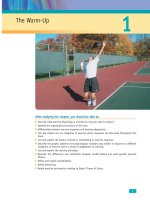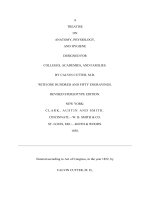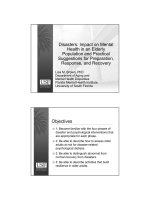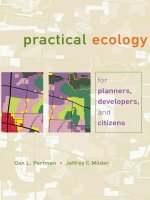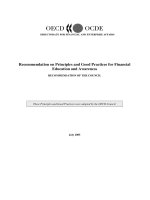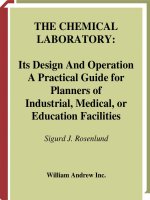Practical Ecology for Planners, Developers, and Citizens potx
Bạn đang xem bản rút gọn của tài liệu. Xem và tải ngay bản đầy đủ của tài liệu tại đây (5.65 MB, 311 trang )
About Island Press
Island Press is the only nonprofit organization in the United States
whose principal purpose is the publication of books on environmental is-
sues and natural resource management. We provide solutions-oriented
information to professionals, public officials, business and community
leaders, and concerned citizens who are shaping responses to environ-
mental problems.
In 2004, Island Press celebrates its twentieth anniversary as the lead-
ing provider of timely and practical books that take a multidisciplinary
approach to critical environmental concerns. Our growing list of titles
reflects our commitment to bringing the best of an expanding body of
literature to the environmental community throughout North America
and the world.
Support for Island Press is provided by the Agua Fund, Brainerd
Foundation, Geraldine R. Dodge Foundation, Doris Duke Charitable
Foundation, Educational Foundation of America, The Ford Foundation,
The George Gund Foundation, The William and Flora Hewlett Founda-
tion, Henry Luce Foundation, The John D. and Catherine T. MacArthur
Foundation, The Andrew W. Mellon Foundation, The Curtis and Edith
Munson Foundation, National Environmental Trust, The New-Land
Foundation, Oak Foundation, The Overbrook Foundation,The David and
Lucile Packard Foundation, The Pew Charitable Trusts, The Rockefeller
Foundation, The Winslow Foundation, and other generous donors.
The opinions expressed in this book are those of the author(s) and
do not necessarily reflect the views of these foundations.
About the Lincoln Institute of Land Policy
The Lincoln Institute of Land Policy, based in Cambridge, Massachusetts,
is a nonprofit and tax-exempt educational institution established in 1974
to study and teach land policy, including land economics and land taxa-
tion. The Institute is supported primarily by the Lincoln Foundation,
which was established in 1947 by Cleveland industrialist John C. Lincoln.
The Institute’s goals are to integrate theory and practice to better
shape land policy decisions and to share understanding about the multi-
disciplinary forces that influence public policy in the United States and
internationally.
The Lincoln Institute seeks to improve the quality of debate and dis-
seminate knowledge of critical issues in land policy by bringing together
scholars, policy makers, practitioners, and citizens with diverse back-
grounds and experience.We study, exchange insights and work toward a
broader understanding of complex land and tax policies. The Institute
does not take a particular point of view, but rather serves as a catalyst to
facilitate analysis and discussion of these issues—to make a difference
today and to help policy makers plan for tomorrow. For more informa-
tion: www. lincolninst.edu.
Practical Ecology
Dedicated to Richard T. T. Forman,
whose life’s work has helped
humans live more harmoniously with nature
Practical Ecology
for Planners, Developers,
and Citizens
Dan L. Perlman
•
Jeffrey C. Milder
Island Press
washington. covelo. london
Copyright © 2004 Lincoln Institute of Land Policy
All rights reserved under International and Pan-American Copyright
Conventions. No part of this book may be reproduced in any form or by any
means without permission in writing from the publisher: Island Press, 1718
Connecticut Ave., Suite 300, NW, Washington, DC 20009.
ISLAND PRESS is a trademark of The Center for Resource Economics.
Library of Congress Cataloging-in-Publication data.
Perlman, Dan L.
Practical Ecology for Planners, Developers, and citizens / Dan L. Perlman,
Jeffrey C. Milder.
p. cm.
Includes bibliographical references and index.
ISBN 1-55963-634-3 (cloth : alk. paper) — ISBN 1-55963-716-1 (pbk. :
alk. paper)
1. Nature—Effect of human beings on. 2. Land use—Environmental
aspects. 3. City planning—Environmental aspects. 4. Regional planning—
Environmental aspects. 5. Urban ecology. 6. Conservation of natural
resources. I. Milder, Jeffrey C. II. Title.
GF75.P47 2004
304.2—dc22 2004012441
British Cataloguing-in-Publication data available.
Printed on recycled, acid-free paper
Design by Teresa Bonner
Artwork by Lisa V. Leombruni
Photographs by Dan L. Perlman and Jeffrey C. Milder
Manufactured in the United States of America
10 9 8 7 6 5 4 3 2 1
∞
320 the portland edge
Senate Bill 100, 17, 110
Service imperatives, 89
Service-delivery function, 93
Service-oriented firms, 14
Settlers, 141–42
Sewers, 194
Shelters for homeless, 285,
288
Shilo Hotels lawsuit, impact
of, 78
Silicon Forest, 15–16, 103,
269
Single-room occupancy
(SRO)
housing, 197
Sisters of the Road Cafe, 285,
289, 295
Skocpol, Theda, 116
Skyscrapers, 174
Smart Growth, 3, 17, 209
Smog alerts, 28–29
Social services, 103
Solid waste disposal system,
38
South Auditorium project,
61
South Park Blocks, 154
South Portland, 154–55
South Waterfront
redevelopment
effort, 178
Southgate, John, 74–76, 79
Sprawl, 28, 208–12
St. Anthony’s Village, 199–
200
St. Francis Park, 293
Stability and quality of life,
17
State planning mandates,
196, 238–40
Sten, Erik, 196, 288, 293
Strategic Investment
Program, 16
Suburban areas, 159
Support services, 295
Sustainable growth, 4, 20–23
Tafari, Jack, 294
Talley, John, 126
Task Force on
Neighborhood
Involvement (TFNI), 94
Tax revolt, 98–99
Tektronix, 15–16
Temperate Forest
Foundation, 113
Terminal One development,
201
Terwilliger, James, 142
Terwilliger Park, 153
Thomson, Ken, 84
Three Es, 20
Tom McCall Waterfront Park,
18, 156–57
Toulan, Nohad, 207
Toxic releases, 29–30
Trader, Felicia, 62, 73
Traditional development,
livability
evaluation, 224–25
Traffic congestion, 230–31,
251
“Tragedy of the
Commons” (Hardin),
260, 276–77
Tram, aerial, 177–78
Transient free zones, 293
Transit-Oriented
Development program,
245–48
Transportation planning:
commitment
to, 16; Downtown Plan of
1972, 173;
mandate and goals, 232–34,
240–42;
parking ratios, 237; peak
period
pricing, 238; political
conflicts, 240;
regional approach, 47–48,
238–40;
Transportation Planning
Rule (TPR),
230, 234–38; vehicle miles of
travel
(VMT) reduction standard,
235–37, 250
Transportation system
(public transit):
buses, 248–49; history and
development, 19, 44, 245–
50; light rail
system, 10, 245–48; north-
south
extension, 77–78, 175–76;
stresses on,
174–75; and urban renewal,
66; use of,
55, 248–49
Transportation Systems
Plan, 244
Travel Time Index, 252
“TravelSmart” project, 253
Tri-Met (MAX) transportation
system,
19, 245–50
Tronti, Mario, 134
Trust for Public Land, 216–18
Tufts study of neighborhood
associations, 84, 87
Unemployment, 23
Unincorporated areas, 194
Union activity, 17
University District, 175–76
Unstable Slopes and Hillside
Constraints Overlay District,
272
Urban growth boundary
(UGB):
decisions to maintain, 44;
expansion
of, 50–51, 52; and housing
costs,
184–86, 201–2; and housing
density,
207; impacts, 2, 17, 57–58;
management challenges, 31;
Metro
responsibility for, 38–40. See
also
Regional urban growth
goals and
objectives (RUGGOs)
Urban Growth Management
Functional
Plan (1998), 264
Contents
List of Figures, Color Plates, and Tables x
Acknowledgments xiii
Introduction 1
Part One. Humans, Nature, and Interactions 5
Chapter 1. Humans Plan 7
New York City’s Water 9
Fire in Colorado 10
Different Ways of Thinking about the Future 11
Planning with Context in Mind 14
Safeguarding Human Communities: Ecological Due Diligence 17
Respecting Natural Processes That Cross Boundaries 17
Chapter 2. An Introduction to Ecology and Biodiversity 21
Biodiversity: The Stuff of Life 21
The Study of Biodiversity: Ecology and Its Subdisciplines 23
Why Protect the Natural Environment and Biodiversity? 27
Native versus Non-Native Biodiversity 29
Factors That Contribute to High Biodiversity 32
Humans: A Part of Nature or Apart from Nature? 33
Chapter 3. When Humans and Nature Collide 36
Consequences of Human Settlement 37
Powerful Effects of Local Human Activity 48
Part Two. The Science of Ecology 51
Chapter 4. Change through Time 53
An Ecological and Land Use History of Petersham, Massachusetts 53
Ecosystems Change Predictably, Sometimes:
Effects of Climate and Succession 57
Ecosystems Change Unpredictably, Sometimes:
Effects of Disturbance 61
Disturbance in the Context of Human Communities 69
Chapter 5. Populations and Communities 72
Levels of Organization in Ecology 73
Population Issues 75
Ecological Communities 81
Planning for Ecosystems, Planning for Species 91
Chapter 6. The Ecology of Landscapes 93
A Word about Scale 95
Form and Function of Matrices, Patches, and Corridors 97
Land Mosaics, Land Transformation, and Implications
for Planning 110
Ecosystem Ecology 118
Freshwater Ecosystems and Their Relation to the Land 121
Ecological Integrity and Sustainability 125
Part Three. Applications 129
Chapter 7. Conservation Planning 131
Different Types of Conservation and Open Space Areas 133
Selecting and Designing Nature Reserves 137
Small Locally Important Reserves and Large Nationally
Important Reserves 148
Chapter 8. Nature in the Neighborhood 151
Values and Functions of Local Natural Areas 152
Planning and Designing Local Open Spaces 158
Benefits and Costs of Interspersing Humans and Nature 164
Chapter 9. Restoration and Management 169
Reclaiming Land after Mining in Butte, Montana 170
Restoring Grasslands in Grayslake, Illinois 171
The Restoration Process 172
Land Management 180
viii Contents
Chapter 10. Ecologically Based Planning and
Design Techniques 186
Using Ecological Data 187
Landscape Scale (Counties and Regions) 188
Sublandscape Scale (Cities, Towns, and Counties) 194
Habitat Scale (Sites and Lots) 202
Protecting Human Safety in the Ecological Context 210
Chapter 11. Principles in Practice 217
Part 1: Residential Development at the Site Scale 219
Part 2: Planning for Growth by Listening to Ecology 228
Afterword 238
Appendix A. Current Status of Biodiversity in
North America 241
Patterns of Diversity across North America 241
Highlights of North American Biodiversity 244
Numbers of Species 245
Patterns of Endemism across North America 245
Current Status and Future Trends 246
Appendix B. Data Sources 248
Conservation Directories and Libraries 248
Maps and Aerial Photos 248
Species and Ecological Community Information 249
Glossary 251
Notes 257
Bibliography 273
About the Authors 283
Index 285
Contents ix
List of Figures, Color Plates,
and Tables
Figures
Figure 1-1 Sample Development Site, a Fifty-Acre Farm 8
Figure 1-2 a–c Hypothetical Contexts for Fifty-Acre Farm 14
Figure 1-3 Habitat Requirements for the Red-Legged Frog 18
Figure 1-4 Red-Spotted Newt 19
Figure 2-1 The San Pedro River of Southeastern Arizona 22
Figure 2-2 Ecosystem Diversity in the San Pedro River Basin 23
Figure 2-3 The Sky Island Mountain Ranges 24
Figure 2-4 Lady Slipper Orchid 31
Figure 3-1 Time Series of Urban Expansion 38
Figure 3-2 House Near Lords Hill in Central Vermont 41
Figure 3-3 Number of Exotic Plant Species by State 43
Figure 4-1 Central Massachusetts in 1830 and 1985 54
Figure 4-2 Migration of Tree Species 55
Figure 4-3 Modern-Day Petersham, Massachusetts 57
Figure 4-4 Dinosaur Footprints in Colorado 58
Figure 4-5 Landslide in Monteverde, Costa Rica 63
Figure 4-6 Long-Term Effects from Yellowstone National Park Fires 65
Figure 5-1 Red-Legged Frog Range Map 73
Figure 5-2 a–e Metapopulations in Urbanizing Areas 78
Figure 5-3 Source and Sink Populations 79
Figure 5-4 Food Web of Red-Legged Frog 83
Figure 5-5 Beaver Pond 89
Figure 6-1 a–c Patches, Corridors, and Matrices 94
Figure 6-2 Land Cover at the Urban–Rural Boundary 98
Figure 6-3 Species Diversity and Patch Size 99
Figure 6-4 Edge Effects 100
Figure 6-5 a–h Types of Human-Created Corridors 106
Figure 6-6 Salamander Tunnel 110
Figure 6-7 Shifting Mosaics 111
Figure 6-8 a–f Land Transformation as a Result of Human Settlement 113
Figure 6-9 Incorporating Biological Conservation and Human Land Use 115
Figure 6-10 a–c Optimal Land Transformation Sequence 117
Figure 7-1 Yellowstone to Yukon Project 132
Figure 7-2 Entrance to Yellowstone National Park 138
Figure 7-3 Hat with Stuffed Birds 139
Figure 7-4 The National Bison Range in Western Montana 140
Figure 7-5 a–e Types of Habitat Corridors 149
Figure 8-1 Local Forest Products 155
Figure 8-2 Children at Nature Area 157
Figure 8-3 Edge Effects at a Small Nature Area 160
Figure 8-4 Mosquito Biting Human 166
Figure 9-1 Reclamation and Restoration 170
Figure 9-2 Headframe in Butte, Montana 171
Figure 9-3 Restored Prairie at Prairie Crossing, Grayslake, Illinois 175
Figure 9-4 Landscaping with Native Species at Prairie Crossing 175
Figure 9-5 Restored Wetlands in Prairie Crossing 176
Figure 9-6 Reclamation Efforts in Butte, Montana 179
Figure 9-7 Restored Native Plants in Butte 180
Figure 9-8 Prescribed Burning of Restored Native Prairie 183
Figure 10-1 Land Suitability Analysis 189
Figure 10-2 Landscape Conservation and Development Plan 191
Figure 10-3 Transfer of Development Rights 194
Figure 10-4 Aesthetic versus Ecological Goals in Site Design 205
Figure 10-5 Impact of Road Construction on Native Habitat 206
Figure 10-6 Sensitive Site Design 207
Figure 10-7 Recent Floodplain Development in Chesterfield, Missouri 211
Figure 11-1 Existing Conditions Plan 220
Figure 11-2 Conventional Subdivision Plan 225
Figure A-1 Distribution of Biomes in North America 242
Figure A-2 Habitat Diversity within Biomes 243
Color Plates
Color Plate 1 Hi-Meadow Fire in Colorado
Color Plate 2 Male Quetzal
Color Plate 3 Species Richness in North America
Color Plate 4 a–b Shoreline Plant Community at Mary Dunn Pond,
Hyannis, Massachusetts
Color Plate 5 Mutualism between Treehopper and Ant
List of Figures, Color Plates, and Tables xi
Color Plate 6 Long-Term Effect of Fires in Yellowstone National Park
Color Plate 7 Reserves and Corridors
Color Plate 8 Using Ecological Data in Land Use Planning
Color Plate 9 Portland 2040 Regional Plan
Color Plate 10 Conservation Subdivision Design
Color Plate 11 Site Ecology Map
Color Plate 12 Ecological Context Map
Color Plate 13 Rural Cluster Plan
Color Plate 14 Village Cluster Plan
Color Plate 15 Local Ecology Map
Color Plate 16 Regional Context Map
Color Plate 17 Natural Hazards Map
Color Plate 18 Community Land Use Plan
Tables
Table 1-1 Different Viewpoints among Professional Disciplines 13
Table 6-1 Scale and Context for Planning and Conservation 96
Table 6-2 Major Human Sources of Nitrogen and
Phosphorus Enrichment 120
Table 6-3 Stream Characteristics 123
Table 6-4 Effects of Land Use on Freshwater Ecosystems
and Biodiversity 124
Table 7-1 Values and Functions of Different Types of Natural Areas 136
Table 7-2 Types of Corridors 148
Table 8-1 Sample Species-Area Relationships for Habitat Patches in
Urban Landscapes 153
Table 8-2 Role of Different Strata in Ecological Landscape Design 163
Table 9-1 Example of Restoration Techniques to Meet Different
Restoration Goals 178
Table 10-1 Overview of Ecologically Sensitive Site
Development Practices 208
xii List of Figures, Color Plates, and Tables
Acknowledgments
This book benefited tremendously from the input, support, and feedback of many
people, and we greatly appreciate their time and efforts. Armando Carbonell of
the Lincoln Institute of Land Policy suggested that we write the book, secured
support from the Lincoln Institute, and was deeply helpful at every stage of the
book’s development. Ann LeRoyer and Lisa Cloutier of the Lincoln Institute pro-
vided thoughtful suggestions and were especially helpful in bringing the book to
fruition. Heather Boyer, our editor at Island Press, was enthusiastic about the
project and helped us get across the finish line during the final months. Our artist,
Lisa Leombruni, put a great deal of effort, skill, and creativity into her work; we
appreciate her talent, her contributions to the book, and especially her patience.
Early in the development of the book, an advisory committee consisting of
Michael Binford, Peter Pollock, Frederick Steiner, and Jon Witten read a first draft
of the book and helped shape the project’s subsequent direction. We appreciate
the time and energy that these advisors gave us, and we hope they recognize the
value of their input.
We also owe our gratitude to those reviewers who read later drafts of the
book and helped us think about how to improve the text: Jeanne Armstrong,
Richard T. T. Forman, Eliza K. Jewett, Robert and Gail Milder, Robert Perlman,
Christopher Ryan, Frederick Steiner, and David Tobias. Finally, we thank the fol-
lowing people who generously offered valuable information on real-life plan-
ning, design, and conservation issues: Steven Apfelbaum, Jae C. Choe, Dan
Cooper, Ed Dobb, Robert O. Lawton, Everose Schluter, Jon Sesso, Frederick
Steiner, and David Tobias.
As anyone who has written a book or lived through the writing of a book
knows, the people who live with the writers deserve the lion’s share of credit for
the book itself. Nora Abrahamer, Jeremy Abrahamer Perlman, and Nina Kohn
gave us the precious gifts of time to write and support when things were most
difficult. Without you, we would not have completed this book. It is your ac-
complishment as much as ours.
To all those who have helped us make this book a reality, thank you.
xiv Acknowledgments
Each year, the United States and Canada add more than 3.5 million people to their
combined population. Each year, our appetite for land and resources grows as
we demand more housing, more cars, more roads, more food, more forest prod-
ucts, and more leisure opportunities. As the human world expands, we leave less
room and fewer resources for native species and ecosystems, and the natural
world suffers. So, too, do we ourselves suffer when we fail to define a harmonious
relationship with nature. Each year, natural disasters such as wildfires, floods, and
devastating hurricanes cost lives and cause billions of dollars of damage to human
communities; from 1995 to 1997, the United States alone suffered about $1 billion
of natural hazard damages each week.
1
More insidiously, generations of children
are growing up separated from nature and the wisdom, pleasure, and spiritual
wealth that it offers.
Some environmentalists would address this crisis by setting aside large por-
tions of the landscape as nature reserves that are off-limits to people. But while
conservation areas are an important part of the solution, they fail to address the
80 or 90 percent of the land that humans do inhabit and use. For these areas, the
challenge is to integrate humans and nature more beneficially by retaining eco-
logical values in largely domesticated landscapes. Planners, designers, and de-
velopers must be at the forefront of this effort, for their activities transform the
landscape in ways that are seldom environmentally neutral. If these profession-
als are not consciously working to bring forth an ecologically sounder world, they
Introduction
are often contributing, if only inadvertently, to the creation of a wasteful and po-
tentially dangerous one.
For those who are inclined to write off ecological issues as tomorrow’s prob-
lem, consider the tangible benefits of and strong mandate for addressing these
problems now:
• Natural ecosystems annually provide humans with trillions of dollars of
unpaid-for “services,” such as flood control and water purification—services
that would otherwise require engineered solutions and large public expen-
ditures if these ecosystems became heavily degraded.
• When communities are designed without a careful understanding of natural
ecological processes, humans expose themselves to health and safety risks
from violent storms, wildfire, disease organisms, and other natural hazards.
• Retaining natural areas in cities and suburbs tends to increase real estate
values, quality of life, and community desirability, thus increasing prof-
itability for land developers and economic competitiveness for communities
and regions.
• In national and local polls, citizens consistently rank environmental protec-
tion as a high priority. Elected and appointed public officials ignore these
sentiments at their own peril.
This book is written for those who are ready to rise to the challenges of har-
monizing human communities and nature in the United States and Canada,
whether they are professional land use planners or members of a local planning
commission, landscape architects or civil engineers who want to design more eco-
logically sound projects, developers or lenders who want to build or finance
greener developments, or citizens interested in improving their towns or regions.
Our focus is on the two central goals of ecologically based land use planning and
landscape design: 1) to conduct human activities on the landscape in a way that
conserves native species and healthy ecosystems, and 2) to promote livable com-
munities that benefit from their surrounding ecosystems while protecting human
health and safety. To help readers advance these goals, the book introduces key
concepts of ecology and conservation biology that are valuable in creating com-
munities and developments more respectful of their natural environment.
In presenting this material, we assume that readers are willing to engage
themselves with a number of interesting and sometimes complex concepts es-
sential to ecologically based planning and design, but we do not presuppose a
great deal of background in these subjects. A major goal of the book is to syn-
thesize and present relevant scientific information in a form that can help answer
the questions that land use professionals and informed citizens face every day.
2 Introduction
We also assume that readers are already interested in creating land use plans, de-
signs, and decisions that are better informed by the scientific understanding that
ecologists and conservationists have developed over the past few decades. This book,
therefore, is not so much an exhortation to conserve nature as a practical expla-
nation of how to do so in the context of land use planning and land development.
How to Use This Book
The three parts of this book lead the reader from concept to application, but these
are closely intertwined throughout in recognition of the relevance of scientific
information to planning and design practice. The first part introduces the para-
digm of ecological thinking and the ways it differs from the planning paradigm.
We then explore the fundamentals of the ecological world and humans’ rela-
tionship to it: What is biodiversity and why is it important? What happens when
human activities impinge on natural systems? How can people prepare mean-
ingful plans in a natural world that is subject to chance and change?
The second part is a primer on ecology and conservation biology that em-
phasizes those aspects of the field most relevant to planners, designers, develop-
ers, and other interested in land use: How does nature change over time? How
predictable are these changes, and what does this mean for planning? How do or-
ganisms and species interact in nature? What causes populations of plants and
animals to thrive, falter, or go extinct? Finally, how does the arrangement of land-
scape elements, such as cities, farms, roads, and nature reserves, affect the form
and function of ecological communities?
The book’s final part discusses how ecological concepts can be applied to the
two goals discussed above: improving the ecological integrity of human-
influenced landscapes and ensuring that humans benefit from and are not en-
dangered by local ecosystems. This part begins with large-scale applications, ex-
amining the factors that should inform the design of nature reserves and the
ways in which human and ecological needs can be integrated across entire land-
scapes. We then move to the scale of communities and sites to discuss the de-
sign of smaller parks and nature areas as well as techniques for managing and
restoring land. Next, we present a range of practical planning and design tech-
niques from an ecological standpoint. The concluding chapter is a two-part plan-
ning exercise that lets readers practice applying the lessons of this book.
This book condenses into accessible form information that could easily fill
several large volumes. For emphasis and convenient reference, important con-
cepts are further distilled in gray boxes throughout the book. This format is tai-
lored to the needs of busy land use professionals and citizens seeking a concise
Introduction 3
overview of ecology and its applications, but such brevity means that much about
each topic has necessarily gone unsaid. We encourage readers to learn more about
these topics in the sources referenced throughout the book.
We hope that this book will help planners, designers, developers, and citizens
become more attuned to the workings of nature and more able to integrate eco-
logical understanding into their work. By paying attention to the ecology of the
places where they work, land use professionals can create a richer, healthier world
for humans and for all living creatures.
4 Introduction
Part One
HUMANS, NATURE,
AND INTERACTIONS
All organisms live in ecological communities just as all people
live in human communities. Often, however, we tend to forget
that human communities also exist within an ecological con-
text—that we cannot survive without the natural world around
us. In this first part of the book, we consider some of the ties be-
tween humans and the ecological settings in which they live. We
also begin to explore how humans can manipulate these ties for
better and for worse.
Chapter 1 discusses what nature can do for us if we carefully
plan interactions between human and ecological communities, as
well as what nature can do to us if we are not careful. We also
emphasize the importance of context and the need to think be-
yond the boundaries of official planning domains to create eco-
logically based plans and designs.
In Chapter 2, we introduce the Earth’s living components,
collectively known as biodiversity. Biodiversity is the focus of
ecologists who try to understand how organisms interact with
one another and their physical environment, and of conserva-
tionists as they determine how best to protect biodiversity. We
explore different reasons why planners, designers, developers,
and citizens may want to protect biodiversity as well as the rea-
sons that the native biodiversity of a region is especially valuable.
Humans have significant impacts on the environments
in which they live—impacts that, over time, can lead to the rise
and fall of entire civilizations. Chapter 3 discusses different types
of human impacts and lays the groundwork for thinking about
how we can lessen these impacts, which is the focus of Part 3 of
this book.
1
Humans Plan
“A man, a plan, a canal, Panama.”
Palindrome describing the creation of the Panama Canal
“I returned, and saw under the sun, that the race is not to the
swift, nor the battle to the strong, neither yet bread to the wise,
nor yet riches to men of understanding, nor yet favor to men of
skill; but time and chance happeneth to them all.”
Ecclesiastes 9:11, King James Bible
Over the past few millennia, humans have spread to cover the globe. In the
process, we have changed more of the earth, more profoundly, than any species
before us. We have altered the face of the planet by building a canal between the
Atlantic and Pacific oceans, reestablishing a connection that had not existed for
more than 2 million years; by cutting vast forests at all latitudes; and by chang-
ing the global climate. As human communities grow, we shape nature. With our
advanced technologies, however, we often forget that nature shapes us as well.
As we extend ourselves across the landscape, we plan. Sometimes our plans
are explicit and carefully thought out documents, while other times they are im-
plicit thoughts, such as, “If I create a farm here, it will be productive for several
years,” or “If we build a town here, it will be a safe place to live.” Plans give us a
secure feeling about the future and reinforce our sense that we can control the
landscapes where we live. Drawings and carefully crafted words describe what a
given site or region will look like if the plan goes into effect—but these plans can
be misleading in two ways.
First, most plans focus primarily on the site or area for which they are plan-
ning. While they may consider roads and other aspects of human society outside
the study area, they rarely consider ecological issues beyond the boundaries. A
certain piece of terrain is either in the study area (and included in the plan) or
out of the study area (and typically ignored). In fact, most plans show virtually
nothing that is outside the planning area or site, as if it were an island floating in
space (see Figure 1-1).
Second, the planning and design process is often built on the assumption that
human beings fully control the future of the study area. A carefully produced
plan is a prediction that verges on being a contract: the plan tells residents of an
area what their subdivision or community will become if the plan is followed. As
a result, plans typically depict only one or, at most, a handful of future states.The
science of ecology, on the other hand, recognizes that “time and chance happeneth
to them all.” Yes, we can plan and predict, but despite the seeming solidity of our
plans’ words and images, we cannot guarantee what the future of a site holds.
The world of nature is full of chance events, and the mere passage of time brings
its own changes as well.
The following two case studies explore the relationship between planning—
a wholly human enterprise—and the workings of nature. As these examples il-
lustrate, planners, designers, and developers would do well to consider the effects
of time, chance ecological events, and ecological processes occurring beyond their
planning area. By taking these factors into account, we can develop plans that
8 HUMANS, NATURE, AND INTERACTIONS
Figure 1-1. This sample site map shows a fifty-acre
(20 ha) farm, including fields, farm buildings, a
stream and wetlands, and some forest. Like many
maps and plans, however, this one shows none of the
context surrounding the farm.
Agricultural Land
Wetland
Pasture / Grassland
Forest
LEGEND
reap major benefits and avoid major problems. By ignoring these factors, we run
the risk of costly or tragic consequences as nature runs its course.
New York City’s Water
Beginning in the mid-nineteenth century, New York City developed one of the
best municipal water supplies in the world in terms of quality, reliability, and in-
novative management.
1
Every day, the city’s water system supplies 9 million
people with 1.3 billion gallons of potable water.
2
The water comes from a sys-
tem of nineteen reservoirs and lakes fed by a 1,969-square-mile (5,099 square
km) watershed that extends more than 100 miles (160 km) north of the city. Per-
haps most remarkable of all is that the foundations of this system were laid
nearly two centuries ago, in 1835.
3
Today, almost all of New York’s water still
comes from upstate watersheds, and the main treatment that it receives is sim-
ply chlorination to kill the pathogens that are sometimes present at low levels.
In 1989, the U.S. Environmental Protection Agency (EPA) promulgated the
Surface Water Treatment Rules, which grew out of the Safe Drinking Water Act
of 1974.
4
Under these rules, New York City would have had to begin filtering its
entire water supply for the first time. The filtration plants, according to the City,
would have cost $6 to $8 billion to build and would have doubled the price of
water for city residents. Instead, throughout the early and mid-1990s, the City
and the EPA worked out an alternative to filtering the main water supply: the
City would protect and improve water quality by helping towns in the watershed
upgrade their sewage treatment facilities and by protecting thousands of acres of
land in critical portions of the watershed. As of this writing, the City has pur-
chased or obtained conservation easements on over 50,000 acres (20,000 ha) of
land in the upstate watersheds.
5
The City alone has committed over $290 million
for the land acquisition program, and city, state, and federal contributions to all
facets of the watershed program total $1.4 billion.
6
One of the most striking features of the agreement between the EPA and the
city is the joint official recognition that nature can perform critical ecosystem
services for humans. Instead of insisting on building giant filtration plants, the
parties recognized that, through proper management, nature may be able to pro-
vide drinking water that is as safe as water provided by purely technological
means. In addition to drinking water benefits, this watershed-based approach is
helping protect rural landscapes just a couple of hours from New York City.
Many farms will remain in business, and people are allowed to hike, fish, and
hunt on much of the land that the city purchases.
In the early nineteenth century, the City of New York recognized that its
water resources would become limiting, and the municipality looked beyond its
Humans Plan 9
borders to create a remarkable water supply system. At the end of the twentieth
century, the city again looked beyond its borders—and beyond the confines of
human technology—to envision a future in which humans protect natural areas
in ways that help both humans and countless nonhuman organisms living across
the landscape. This example offers the following lessons:
• Sometimes we are better served by letting nature provide necessary services
than by using technology to fulfill our needs. When we protect and main-
tain healthy ecosystems, humans can reap significant health and economic
benefits.
• By setting aside parcels of nature for one purpose—in this case, to provide
safe drinking water—both human and ecological communities may benefit
in other ways. The watershed lands protect the rural character of dozens of
communities as well as high-quality habitat for the region’s native species.
While looking beyond the boundaries of a site can help identify the benefits
and services that nature provides, taking a broad view can also help one avoid
some of the problems that nature can bring, as the next case study illustrates.
Fire in Colorado
Several years ago, some friends of ours purchased a house in Pine, Colorado. This
small community, nestled beside and within the Pike National Forest, has become
a bedroom community for Denver as the capacity of the highways into the city
has expanded. The mountain ridges surrounding Pine are covered with matur-
ing pine forests that are not only lovely to look at but also contain a surprisingly
intact ecological community that includes black bear, elk, mule deer, coyotes, and
even mountain lions—all less than an hour’s drive from Denver. This ecosystem
offers aesthetic and recreational amenities that have undoubtedly contributed to
Pine’s recent popularity among home buyers.
This ecosystem, however, is not entirely benign. Although the setting of our
friends’ house appears quite suburban, with several houses visible nearby, moun-
tain lions are enough of a danger that many children do not play outside at dusk
or dawn. But the single most notable species in this ecosystem is not one of the
large mammal species but rather the Ponderosa pines (Pinus ponderosa) that
dominate the landscape. And the single most notable process in the ecosystem
is fire.
Left alone, Ponderosa pine forests typically burn lightly and frequently, with
ground fires removing underbrush while leaving mature trees intact. However,
in areas where fires have long been suppressed and underbrush has been allowed
to accumulate, as is the case throughout much of the American West, fires burn
10 HUMANS, NATURE, AND INTERACTIONS

